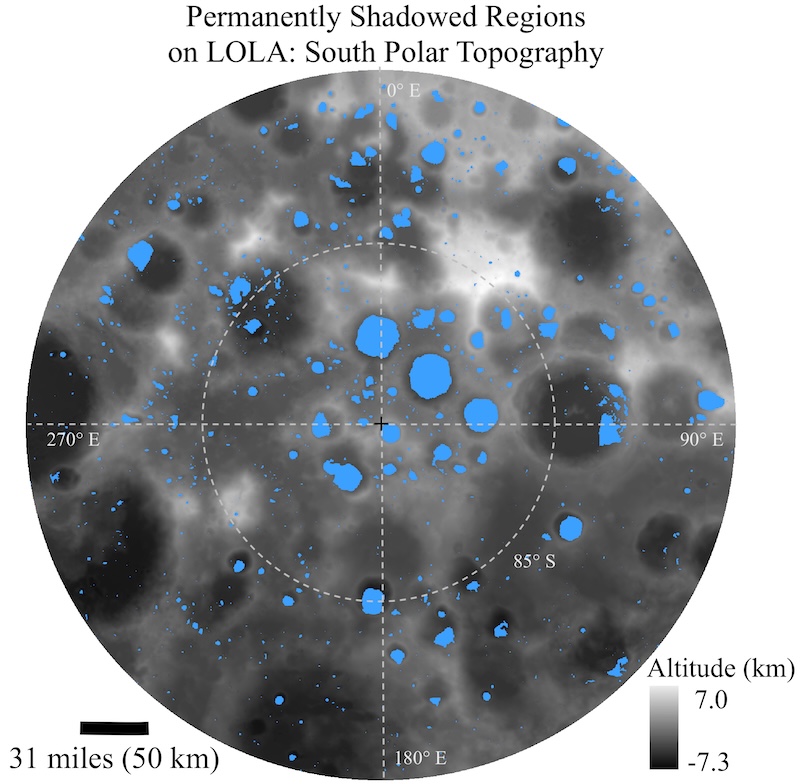
- We know there’s water ice in deep, shadowed craters, near the moon’s poles. The ice remains frozen due to the lack of sunlight and extreme cold.
- But there’s even more ice on the moon than we previously knew, according to a new NASA study. The evidence comes from data obtained by NASA’s Lunar Reconnaissance Orbiter.
- Ice on the moon is of high interest to future moon explorers. It can be used to create drinking water, air and even rocket fuel.
The moon is an extremely dry place compared to Earth. There are no rivers or lakes, not even puddles. There are, however, water molecules bound in the lunar regolith, or soil. And there are ice deposits, primarily near the moon’s South Pole. And now, a new study by NASA scientists shows that ice deposits are widespread and more extensive than first thought. The researchers said on October 3, 2024, that new analysis of data from NASA’s Lunar Reconnaissance Orbiter (LRO) revealed the additional deposits.
The researchers published their peer-reviewed findings in The Planetary Science Journal on October 2, 2024.
Ice on the moon more widespread than thought
Scientists have known for some time that there are ice deposits in permanently shadowed regions in craters near the moon’s South Pole. But the new study reveals ice deposits well outside of that region.
Timothy McClanahan at NASA’s Goddard Space Flight Center in Greenbelt, Maryland, is the lead author of the study. He said:
We find that there is widespread evidence of water ice within PSRs outside the South Pole, towards at least 77 degrees south latitude. Our model and analysis show that greatest ice concentrations are expected to occur near the PSRs’ coldest locations below 75 Kelvin (-198°C or -325°F) and near the base of the PSRs’ poleward-facing slopes.
The researchers don’t know yet exactly how much ice there is or how deep it may be buried. McClanahan continued:
We can’t accurately determine the volume of the PSRs’ ice deposits or identify if they might be buried under a dry layer of regolith. However, we expect that for each surface 1.2 square yards (1 square meter) residing over these deposits there should be at least about five more quarts (five more liters) of ice within the surface top 3.3 feet (1 meter), as compared to their surrounding areas.

Why do we care about ice deposits on the moon?
Ice on the moon is important to space fans. It represents a potential source of water for future astronauts on the moon’s surface, and, for us humans, water means live. Future lunar astronauts might be able to use the lunar ice for drinking water, oxygen (from the oxygen component of water), and even rocket fuel (hydrogen) without needing to transport large quantities from Earth. This possibility would make lunar exploration more sustainable.
What’s more, studying lunar ice could provide valuable insights into the early solar system and the history of impacts on the moon by comets and asteroids.
How did the researchers find the ice deposits?
For the new study, the scientists used data from instruments on NASA’s Lunar Reconnaissance Orbiter (LRO). In particular, the Lunar Exploration Neutron Detector (LEND) instrument and LEND’s Collimated Sensor for Epithermal Neutrons (CSETN).
The instruments measured moderate-energy or “epithermal” neutrons on the lunar surface. Neutrons originate from intense, high-energy cosmic rays, which come from cosmic events such as exploding stars. Along with protons, they make up the nucleus of every atom except ordinary hydrogen. Eventually, some of the cosmic rays impact the moon. They break up the already existing atoms in the regolith and create subatomic neutrons.
The neutrons can collide with other atoms in the regolith. As a result, some of them will be ejected out into space. LEND can then easily detect them, since there is virtually no atmosphere on the moon.
How does that help find the ice? The water in the ice is made of hydrogen atoms. And hydrogen atoms have a similar mass to neutrons. So when a neutron collides with a hydrogen atom, the neutron loses more energy than it would from colliding with most other atoms. That tells scientists the atom it collided with was a hydrogen atom. Which means water, frozen as ice since it can’t be liquid.
How did the ice get there?
Since the moon has no other liquid water and no atmosphere to speak of, how did the ice get there? There are three main possibilities. One is that it is delivered by comet or meteor impacts. Another is that it originates as gas from the interior of the moon itself that freezes on the surface. Chemical reactions between hydrogen in the solar wind and oxygen in the lunar regolith could also produce the ice.
The ice can persist for billions of years because it is in the permanently shadowed regions (PSRs) of deep craters near the poles. So the ice never sees any sunlight, and therefore the PSRs are also extremely cold. In such regions, there might even be enough ice for future astronauts to mine.
The findings are good news for the prospect of human settlement on the moon in the future. The ice, melted as water, could be used not only for drinking, but also to make rocket fuel, energy and breathable air. It could even be used to help protect from radiation.
Bottom line: A new NASA study of permanently shadowed regions near the lunar South Pole shows that there is a lot more water ice on the moon than previously thought.
Source: Evidence for Widespread Hydrogen Sequestration within the Moon’s South Pole Cold Traps
Read more: What’s the source of the ice at the moon’s South Pole?











